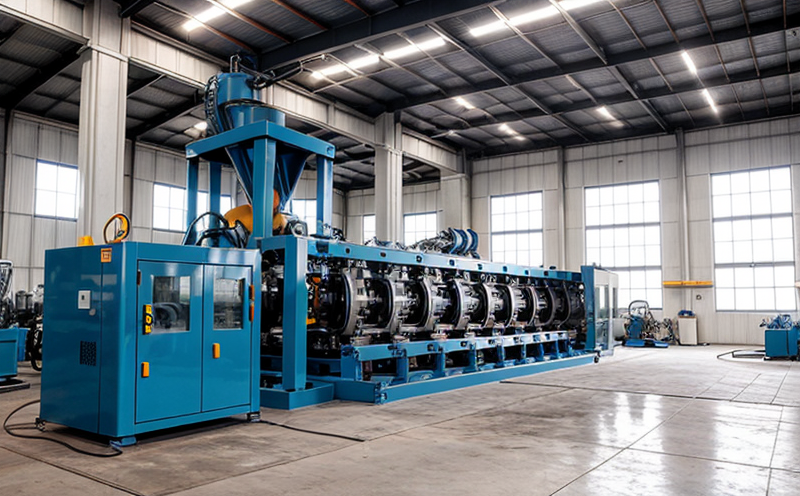ISO 9906 Pump Hydraulic Performance Testing
The ISO 9906 standard is a critical benchmark in the field of industrial machinery testing, specifically focusing on pump hydraulic performance. This comprehensive test ensures that pumps operate within specified parameters and meet international quality standards. Pumps are essential components in various industries, including oil & gas, chemical processing, water treatment, and HVAC systems.
The ISO 9906 standard evaluates the hydraulic efficiency of pumps by measuring key performance indicators such as head pressure, flow rate, and power consumption. These metrics help determine whether a pump is operating efficiently under its design conditions. The test aims to identify any discrepancies between theoretical specifications and actual operational parameters, which could lead to inefficiencies or potential failures.
During the testing process, pumps are subjected to various operating conditions that simulate real-world scenarios. This includes varying flow rates, pressures, and temperatures. Specimen preparation involves ensuring the pump is clean and free from any foreign materials before testing begins. The test setup typically consists of a pump connected to a hydraulic bench equipped with sensors for measuring pressure, flow rate, and power consumption.
The testing methodology outlined in ISO 9906 requires the use of specific apparatus, including flow meters, manometers, and wattmeters. These instruments provide accurate measurements that are essential for determining the pump's performance. The test procedure involves running the pump under different operating conditions to gather data on its efficiency across various parameters.
The results from ISO 9906 testing are presented in a detailed report that includes graphs and tables showing the pump's performance metrics. This information is crucial for quality managers, compliance officers, and R&D engineers who need to ensure that their equipment meets international standards. The report also serves as a valuable tool for procurement departments by providing insights into potential suppliers' capabilities.
ISO 9906 testing plays a vital role in maintaining the reliability and efficiency of pumps used in industrial processes. By adhering to this standard, manufacturers can ensure that their products meet stringent quality requirements and perform consistently across different operating conditions. This not only enhances customer satisfaction but also contributes to environmental sustainability by reducing energy consumption.
The competitive advantage of adopting ISO 9906 testing lies in its ability to identify potential issues early on in the production cycle, allowing for corrective actions to be taken promptly. This proactive approach helps prevent costly downtime and ensures that products meet regulatory requirements effectively. Additionally, compliance with international standards enhances a company's reputation among clients and stakeholders.
- It fosters trust and reliability within the industry.
- Promotes innovation by encouraging continuous improvement in pump design and manufacturing processes.
The market impact of ISO 9906 testing extends beyond individual companies; it contributes to overall sector growth by promoting best practices and fostering collaboration among stakeholders. As more industries recognize the importance of this standard, demand for compliant products increases, driving innovation and competitiveness within the global marketplace.
Applied Standards
The ISO 9906 Pump Hydraulic Performance Testing standard is widely recognized and used globally. It provides a standardized approach to evaluating pump efficiency, which ensures consistency in testing results across different laboratories and regions. This standard is particularly relevant for industrial manufacturing and processing sectors where pumps play a crucial role in various processes.
ISO 9906 covers both positive displacement pumps (such as gear pumps) and centrifugal pumps used in various applications. The test procedure outlined in the standard applies to pumps operating within specific pressure ranges, typically up to 140 bar for positive displacement pumps and 75 bar for centrifugal pumps.
The methodology involves measuring key performance indicators such as:
- Flow rate
- Head pressure
- Power consumption
- Volumetric efficiency
For positive displacement pumps, the test focuses on volumetric efficiency, which is defined as the ratio of actual flow rate to theoretical flow rate. For centrifugal pumps, both hydraulic and mechanical efficiencies are evaluated. Hydraulic efficiency reflects the pump's ability to convert input power into useful output power, while mechanical efficiency considers losses due to frictional forces.
The results from ISO 9906 testing provide valuable insights for quality managers, compliance officers, R&D engineers, and procurement personnel involved in selecting and validating pumps for industrial applications. By ensuring adherence to this standard, organizations can enhance their operational effectiveness and meet regulatory requirements more efficiently.
Scope and Methodology
The scope of ISO 9906 Pump Hydraulic Performance Testing encompasses the evaluation of pump efficiency under specific operating conditions designed to mimic real-world scenarios. This comprehensive testing ensures that pumps function optimally and meet international quality standards, which is particularly important in industries reliant on robust pumping systems.
During the test, pumps are subjected to various combinations of flow rates, pressures, and temperatures to simulate different operational environments. The primary objective is to measure key performance indicators such as flow rate, head pressure, and power consumption accurately. These measurements serve as a basis for evaluating the pump's efficiency and identifying any discrepancies between theoretical specifications and actual performance.
The testing procedure outlined in ISO 9906 involves several steps:
- Preparation of the pump: Ensuring it is clean and free from foreign materials before testing begins.
- Connection to a hydraulic bench equipped with sensors for measuring pressure, flow rate, and power consumption.
- Routine operation under different operating conditions to gather data on efficiency metrics.
The results from ISO 9906 testing provide a detailed report that includes graphs and tables showing the pump's performance metrics. This information is crucial for quality managers, compliance officers, R&D engineers, and procurement personnel involved in selecting and validating pumps for industrial applications. The report also serves as a valuable tool for identifying areas where improvements can be made to enhance efficiency and reliability.
Adhering to ISO 9906 testing not only ensures that the pump meets strict performance criteria but also enhances operational effectiveness by highlighting any issues early on in the production cycle. This proactive approach helps prevent costly downtime and ensures compliance with regulatory requirements effectively.





